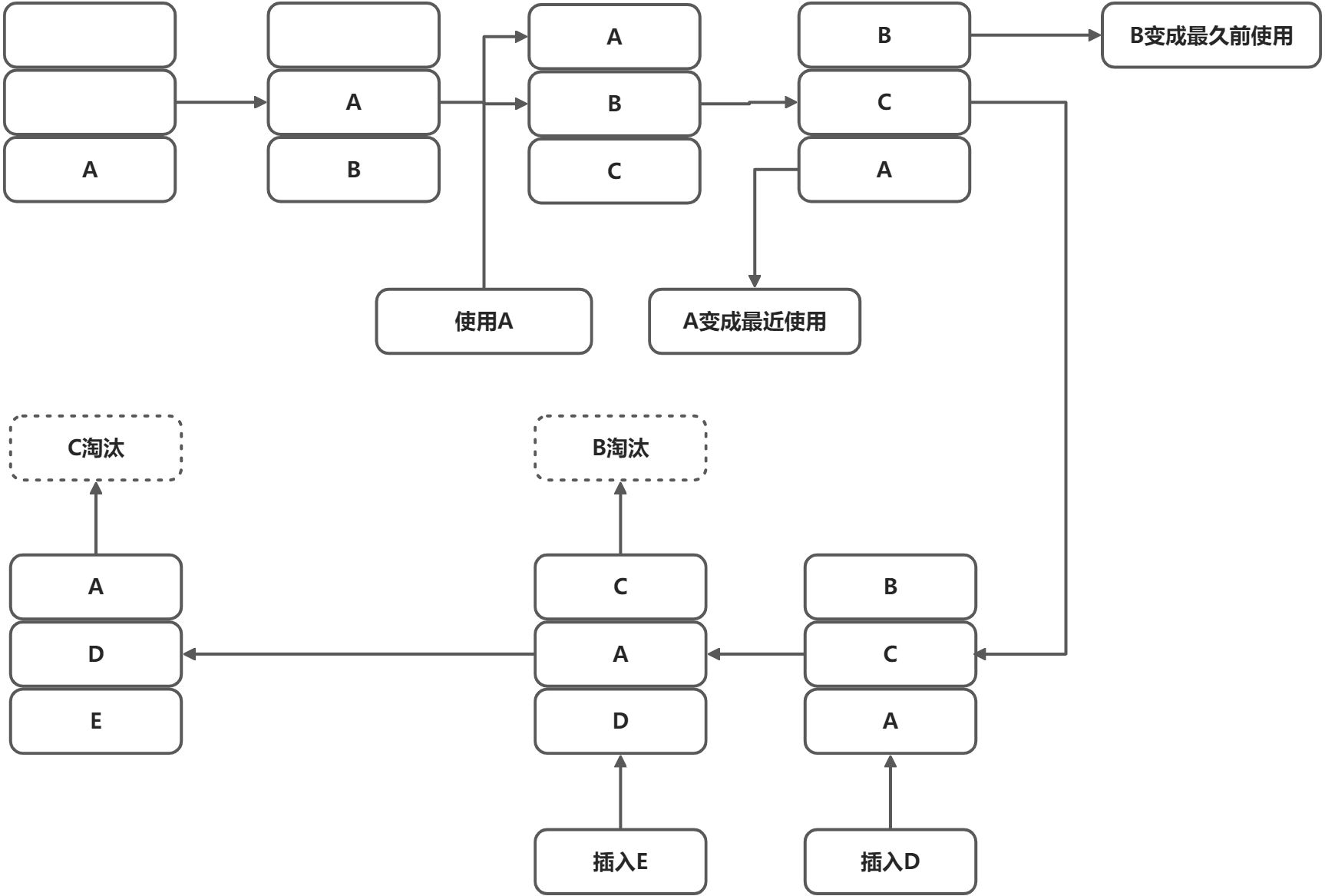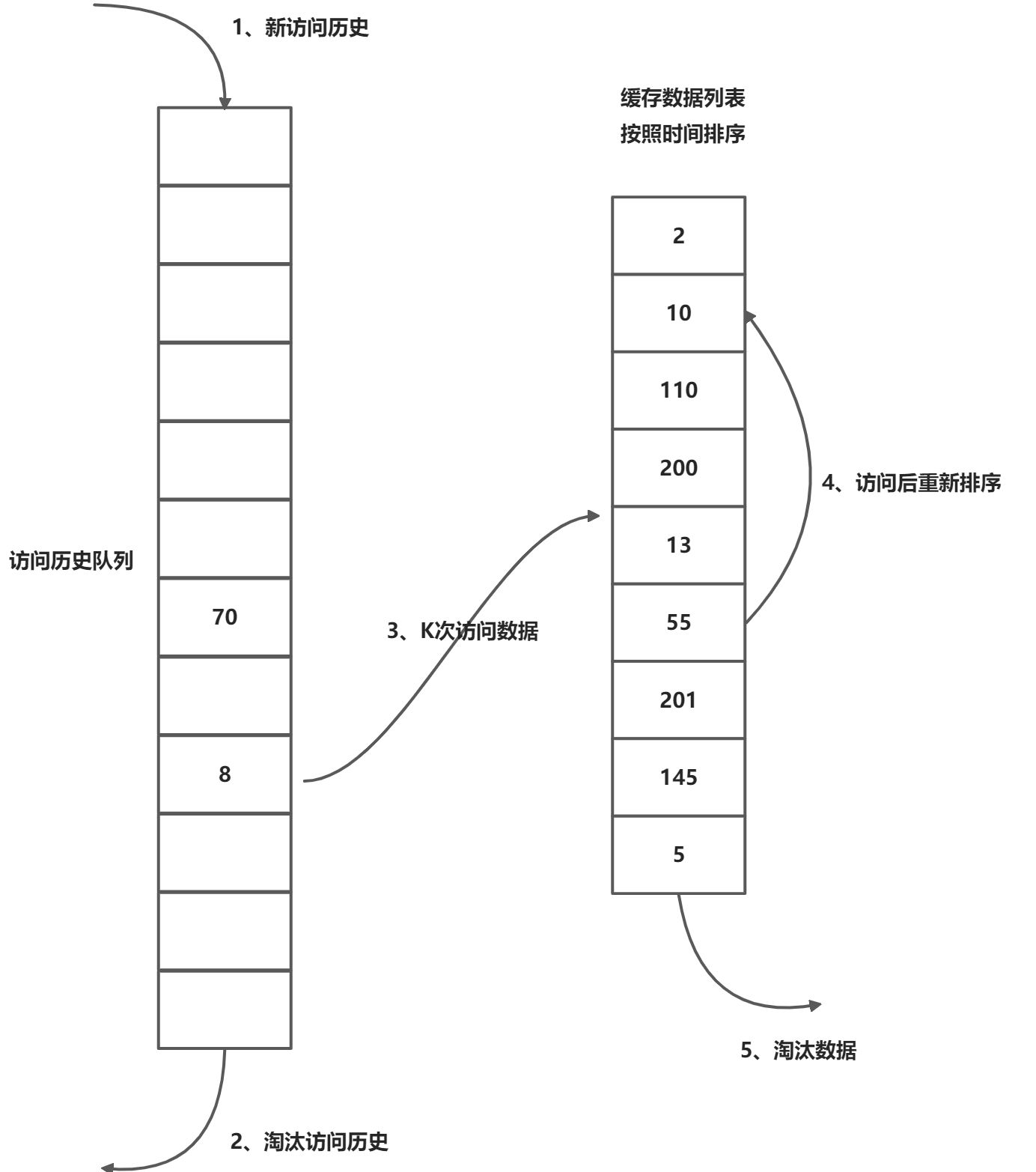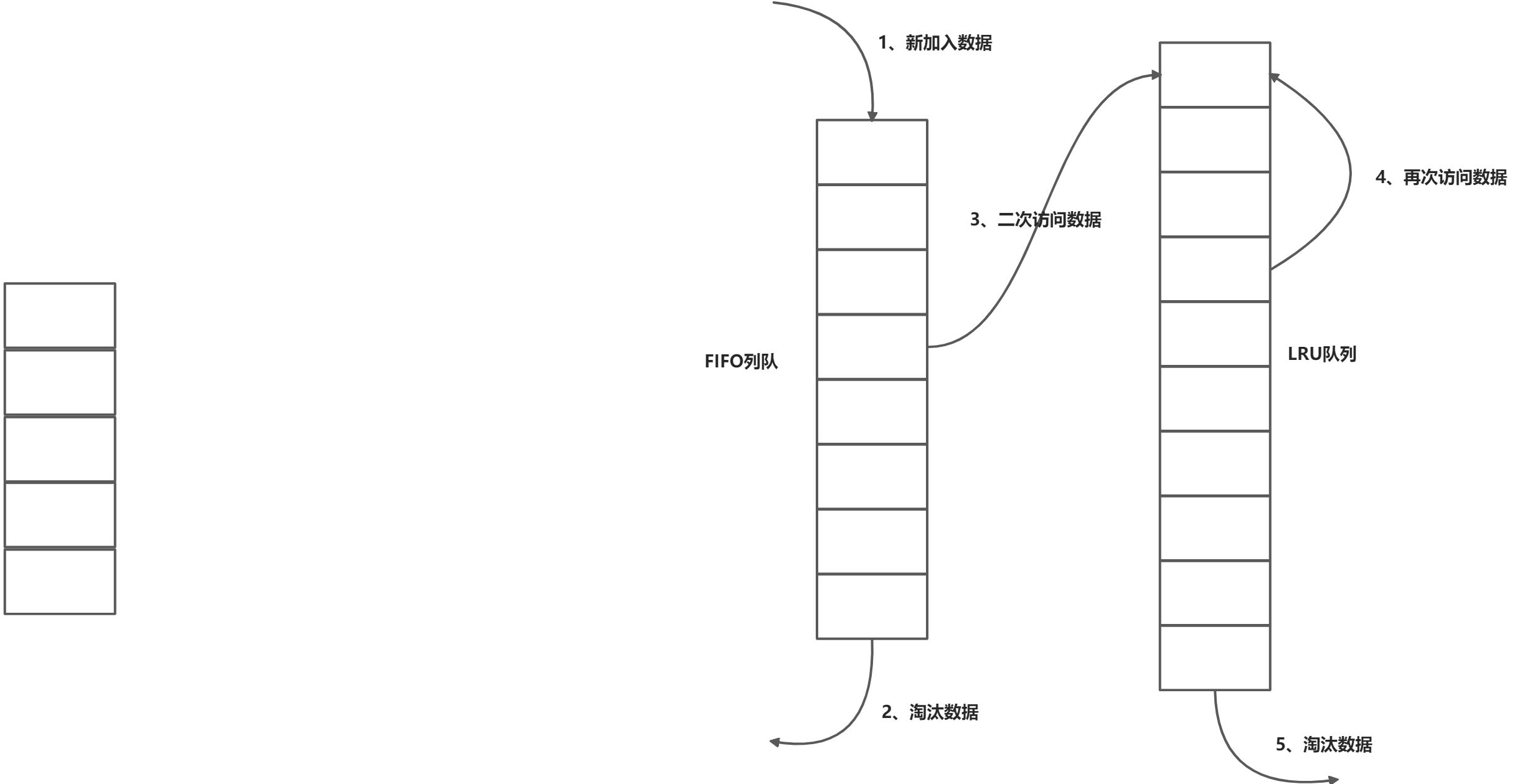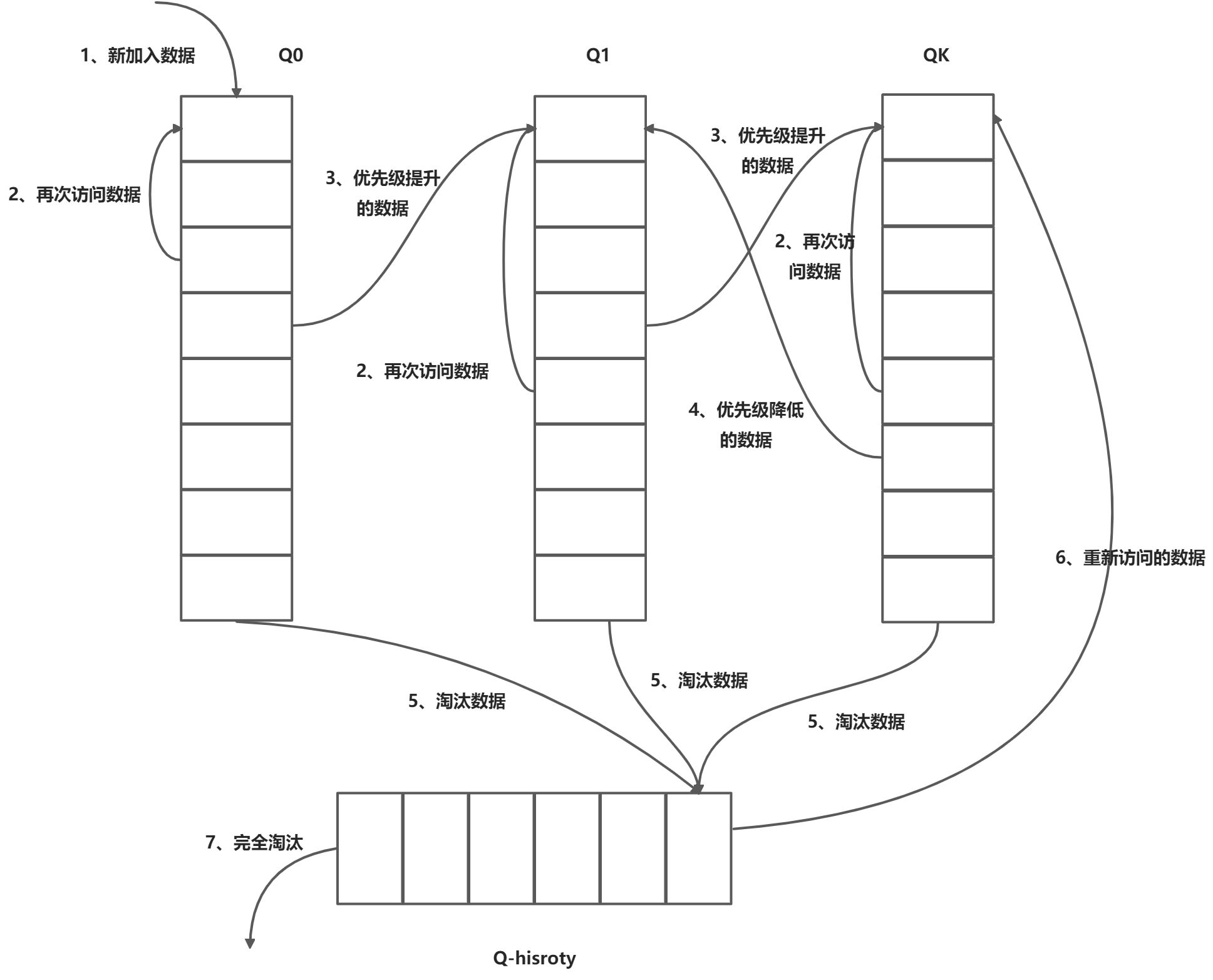标签:get LRU key put Integer public lruCache
LRU算法
LRU(Least Recently used 最近最少使用)算法是一种缓存淘汰算法,算法会根据数据的历史访问记录来进行淘汰数据,最近最少使用的数据将被淘汰,其核心思想是“如果数据最近被访问过,那么将来被访问的几率也更高”。
简单原理

朴素的的LRU算法
- 基于数组
- 基于长度有限的双向链表
- 基于双向链表和哈希表
基于双向链表+哈希表实现LRU

import java.util.HashMap;
import java.util.Map;
public class LRUCache {
private int size; // 当前容量
private final int capacity; // 限制大小
private final Map<Integer, DoubleQueueNode> map; // 数据和链表中节点的映射
private final DoubleQueueNode head; // 头结点 避免null检查
private final DoubleQueueNode tail; // 尾结点 避免null检查
public LRUCache(int capacity) {
this.capacity = capacity;
this.map = new HashMap<>(capacity);
this.head = new DoubleQueueNode(0, 0);
this.tail = new DoubleQueueNode(0, 0);
this.head.next = tail;
}
public Integer get(Integer key) {
DoubleQueueNode node = map.get(key);
if (node == null) {
return null;
}
//数据在链表中,则移至链表头部
moveToHead(node);
return node.val;
}
public Integer put(Integer key, Integer value) {
Integer oldValue;
DoubleQueueNode node = map.get(key);
//数据不存在
if (null == node) {
//插入前先淘汰下数据
eliminate();
//数据不在链表中,插入数据至头部
DoubleQueueNode newNode = new DoubleQueueNode(key, value);
DoubleQueueNode headNextTemp = head.next;
headNextTemp.pre = newNode;
newNode.next = headNextTemp;
newNode.pre = head;
head.next = newNode;
map.put(key, newNode);
size++;
oldValue = null;
} else {
//数据在链表中,则移至链表头部
moveToHead(node);
oldValue = node.val;
node.val = value;
}
return oldValue;
}
public Integer remove(Integer key) {
DoubleQueueNode doubleQueueNode = map.get(key);
if (doubleQueueNode == null) {
return null;
}
doubleQueueNode.pre.next = doubleQueueNode.next;
doubleQueueNode.next.pre = doubleQueueNode.pre;
map.remove(key);
return doubleQueueNode.val;
}
// 将节点插入至头部节点
private void moveToHead(DoubleQueueNode node) {
node.pre.next = node.next;
node.next.pre = node.pre;
DoubleQueueNode headNextTemp = head.next;
head.next = node;
node.next = headNextTemp;
node.pre = head;
headNextTemp.pre = node;
}
private void eliminate() {
if (size < capacity) {
return;
}
//将链表中最后一个节点去除
DoubleQueueNode last = tail.pre;
map.remove(last.key);
last.pre.next = tail;
tail.pre = last.pre;
size--;
last = null;
}
static class DoubleQueueNode {
int key;
int val;
DoubleQueueNode pre;
DoubleQueueNode next;
public DoubleQueueNode(int key, int val) {
this.key = key;
this.val = val;
}
}
public static void main(String[] args) {
LRUCache lruCache = new LRUCache(3);
lruCache.put(1, 110);
lruCache.put(2, 120);
lruCache.put(3, 130);
System.out.println(lruCache);
Integer integer = lruCache.get(1);
System.out.println(integer);
System.out.println(lruCache);
lruCache.put(4, 140);
System.out.println(lruCache);
}
@Override
public String toString() {
StringBuilder res = new StringBuilder();
DoubleQueueNode pre = tail;
while (pre != null) {
res.append(" [").append(pre.key).append("=").append(pre.val).append("] ");
pre = pre.pre;
}
return res.toString();
}
}
View Code
put()和get()操作的时间复杂度都是O(1),空间复杂度为O(N)。
基于LinkedHashMap实现的LRU

import java.util.LinkedHashMap;
import java.util.Map;
public class LinkedHashMapLRUCache extends LinkedHashMap {
private final int capacity;
public LinkedHashMapLRUCache(int capacity) {
//将LinkedHashMap的accessOrder设为true
super(16, 0.75f, true);
this.capacity = capacity;
}
@Override
protected boolean removeEldestEntry(Map.Entry eldest) {
return super.size() >= capacity;
}
public static void main(String[] args) {
LinkedHashMapLRUCache lruCache = new LinkedHashMapLRUCache(4);
lruCache.put(1,110);
lruCache.put(2,120);
lruCache.put(3,130);
System.out.println(lruCache);
Object obj = lruCache.get(1);
System.out.println(obj);
System.out.println(lruCache);
lruCache.put(4,140);
System.out.println(lruCache);
}
}
View Code
默认LinkedHashMap并不会淘汰数据,所以重写它的removeEldestEntry()方法,当数据数量达到预设上限后,淘汰数据,accessOrder设为true意为按照访问的顺序排序。
LRU算法优化
LRU-K
相比LRU,LRU-K需要多维护一个队列,用于记录所有缓存数据被访问的历史。只有当数据的访问次数到达了K的时候,才将数据放进缓存。当需要淘汰数据时,LRU-K会淘汰第K次访问时间距离当前时间最大的数据。

- 数据第一次访问,加入访问历史列表
- 如果数据存在访问历史列表里后没有达到K次访问,按照一定的规则(FIFO,LRU)淘汰
- 当访问历史队列中的数据访问次数到达K次后,将数据索引从历史队列删除,将数据移到缓存队列中,并缓存此数据,缓存队列重新按照时间排序
- 缓存数据队列被再次访问后,重新排序
- 需要淘汰数据时,淘汰缓存队列中排在末尾的数据,即:淘汰倒数第K次访问离现在最久的数据

public class LRUKCache extends LRUCache {
private int k; // 进入缓存队列的评判标准
private final LRUCache historyList; // 访问数据历史记录
public LRUKCache(int capacity, int historyCapacity, int k) {
super(capacity);
this.k = k;
this.historyList = new LRUCache(historyCapacity);
}
@Override
public Integer get(Integer key) {
//记录数据访问次数
Integer historyCount = historyList.get(key);
historyCount = null == historyCount ? 0 : historyCount;
historyList.put(key, ++historyCount);
return super.get(key);
}
@Override
public Integer put(Integer key, Integer value) {
if (value == null) {
return null;
}
if (super.get(key) != null) {
return super.put(key, value);
}
// 如果已经在缓存里则直接返回缓存中的数据
Integer historyCount = historyList.get(key);
historyCount = null == historyCount ? 0 : historyCount;
if (historyCount >= k) {
//移除访问历史记录
historyList.remove(key);
return super.put(key, value);
}
return null;
}
@Override
public String toString() {
return "LRUKCache{" +
"k=" + k +
", historyList=" + historyList +
"}LRUCache{" + super.toString() + "}";
}
public static void main(String[] args) {
LRUKCache lrukCache = new LRUKCache(4, 5, 3);
System.out.println(lrukCache);
Integer integer = lrukCache.get(1);
lrukCache.get(1);
lrukCache.get(1);
lrukCache.get(2);
lrukCache.get(2);
lrukCache.put(1, 111);
lrukCache.put(2, 122);
lrukCache.put(3, 133);
System.out.println(integer);
System.out.println(lrukCache);
lrukCache.put(4, 144);
System.out.println(lrukCache);
}
}
View Code
当K的值越大,则缓存的命中率越高,但是也会使得缓存难以被淘汰。综合来说,使用LRU-2的性能最优。
Two Queue
Two Queue可以说是LRU-2的一种变种,将数据访问历史改为FIFO队列。好处的明显的,FIFO更简易,耗用资源更少,但是相比LRU-2会降低缓存命中率。


import java.util.LinkedHashMap;
import java.util.Map;
public class TwoQueueCache extends LinkedHashMap<Integer, Integer> {
private final int k;
private final int historyCapacity;
private final LRUCache lruCache;
public TwoQueueCache(int cacheSize, int historyCapacity, int k) {
// 这里设置LinkedHashMap的accessOrder为false,默认不设置就是false
super();
this.k = k;
this.historyCapacity = historyCapacity;
this.lruCache = new LRUCache(cacheSize);
}
@Override
protected boolean removeEldestEntry(Map.Entry<Integer, Integer> eldest) {
return super.size() >= historyCapacity;
}
public Integer get(Integer key) {
// 记录访问记录
Integer historyCount = super.get(key);
historyCount = historyCount == null ? 0 : historyCount;
super.put(key, ++historyCount);
return lruCache.get(key);
}
public Integer put(Integer key, Integer value) {
if (value == null) {
return null;
}
// 如果已经在缓存里则直接返回缓存中的数据
if (lruCache.get(key) != null) {
return lruCache.put(key, value);
}
Integer historyCount = super.get(key);
historyCount = historyCount == null ? 0 : historyCount;
if (historyCount >= k) {
lruCache.put(key, value);
return lruCache.get(key);
}
return null;
}
@Override
public String toString() {
return "TwoQueueCache{" +
"k=" + k +
", historyCapacity=" + historyCapacity +
", lruCache=" + lruCache +
'}' + super.toString();
}
public static void main(String[] args) {
TwoQueueCache twoQueueCache = new TwoQueueCache(4, 5, 3);
Integer integer = twoQueueCache.get(1);
twoQueueCache.get(1);
twoQueueCache.get(1);
twoQueueCache.get(2);
twoQueueCache.get(2);
twoQueueCache.put(1, 111);
twoQueueCache.put(2, 122);
twoQueueCache.put(3, 133);
System.out.println(integer);
System.out.println(twoQueueCache);
twoQueueCache.put(4, 144);
System.out.println(twoQueueCache);
}
}
View Code
FIFO队列直接使用继承LinkedHashMap,并且accessOrder默认为false,按照插入顺序排序,通过重写removeEldestEntry()方法来自动淘汰最早插入的数据。
Multi Queue

- 数据插入和访问:当数据首次插入时,会放入到优先级最低的Q0队列。当再次访问时,根据LRU的规则,会移至队列头部。当根据访问次数计算的优先级提升后,会将该数据移至更高优先级的队列的头部,并删除原队列的该数据。同样的,当该数据的优先级降低时,会移至低优先级的队列中。
- 数据淘汰:数据淘汰总是从最低优先级的队列的末尾数据进行,并将它加入到Q-history队列的头部。如果数据在Q-history数据中被访问,则重新计算该数据的优先级,并将它加入到相应优先级的队列中。否则就是按照LRU算法完全淘汰。
LRU应用场景
- 底层的内存管理,页面置换算法
- 一般的缓存服务,memcache\redis之类
- 部分业务场景
标签:get,LRU,key,put,Integer,public,lruCache 来源: https://www.cnblogs.com/sustan/p/15828338.html
本站声明: 1. iCode9 技术分享网(下文简称本站)提供的所有内容,仅供技术学习、探讨和分享; 2. 关于本站的所有留言、评论、转载及引用,纯属内容发起人的个人观点,与本站观点和立场无关; 3. 关于本站的所有言论和文字,纯属内容发起人的个人观点,与本站观点和立场无关; 4. 本站文章均是网友提供,不完全保证技术分享内容的完整性、准确性、时效性、风险性和版权归属;如您发现该文章侵犯了您的权益,可联系我们第一时间进行删除; 5. 本站为非盈利性的个人网站,所有内容不会用来进行牟利,也不会利用任何形式的广告来间接获益,纯粹是为了广大技术爱好者提供技术内容和技术思想的分享性交流网站。

